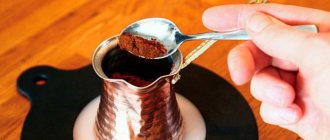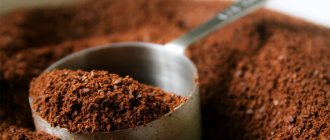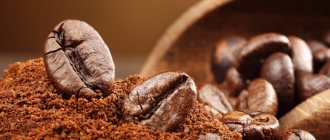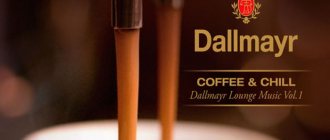What is instant coffee
This concept hides a powdered, granulated and freeze-dried drink produced using a special technology from substandard Robusta beans, less often Arabica beans.
They are fried, crushed, poured with boiling water and undergo several more complex transformations before reaching the store counter.
Instant coffee always contains caffeine, even if the package is labeled as decaffeinated. The strictest American standards allow up to 3 mg of caffeine in one standard cup of drink. How does a drink made from instant powder differ from a natural one?
- Natural contains a large number of oils, which give it a rich aroma and taste. In soluble they are not present in their natural form due to the peculiarities of the technological process.
- Soluble contains many chemical additives from flavorings and flavor enhancers to artificial oils. This is done in order to bring its taste as close as possible to natural.
- The caffeine content in a cup of instant drink is an order of magnitude higher than in a cup of drink made from natural grains.
Freeze-dried coffee contains more useful substances than powdered coffee, as it is produced using freezing technology
Instant coffee gives a boost of energy by stopping the relaxation reactions that the nervous system sends to the entire body when it needs rest to recuperate. The effect is quick but short-lived and often leads to an even greater desire to rest or even fall asleep.
Coffee beans - benefits and harms
Aromatic and tasty coffee is obtained from high-quality beans that are ground right before brewing. As the founder of the Zdravnitsa psychosomatics center Dmitry Raevsky notes, natural coffee has many more beneficial properties than harmful ones :
— Liver . The production of liver enzymes and the functioning of the gallbladder are stimulated, which leads to a low likelihood of stone formation;
— Protection from stress, depression , preserves mental health. The aroma of coffee itself is already capable of setting one in a lyrical mood;
— Beneficial effect on the cardiovascular system . Research from the American Heart Association has shown that just one cup of coffee a day will reduce the risk of heart failure by 7%;
— Reduces the risk of stroke, especially in women, by 40%, since moderate regular consumption of coffee improves the functioning of small blood vessels ;
Photo source: pixabay.com
- Prevents Parkinson's disease , as caffeine prevents the destruction of nerve cells.
This is interesting: Coca-Cola will launch sales of grain and ground coffee in Russia
From time to time, research results appear in the press confirming the harm from coffee:
— In older people, especially women, coffee can lead to osteoporosis , increased bone fragility. With age, the level of calcium in the body decreases, and coffee, having a diuretic effect, promotes greater leaching of calcium. In this case, coffee consumption must be strictly controlled.
— The positive effect of coffee on the cardiovascular system was mentioned above, but it will be a big disadvantage if you drink the same coffee with cream and a lot of sugar. The substance it contains, like cafestol, will promote the formation and accumulation of “bad cholesterol”, and this is not far from atherosclerosis and heart attack .
— For people under constant stress, excessive consumption of coffee can lead to exhaustion of the nervous system, spasm of cerebral vessels, and even death .
Photo source: pixabay.com
How much caffeine is in a cup
It is impossible to answer the question with 100% accuracy. The content of the stimulating alkaloid depends on the type of bean, the amount of finished coffee in the cup and the volume of water.
On average, a 250 ml cup can contain from 45 to 100 mg. There is an opinion that the more expensive the drink, the more psychostimulating alkaloid it contains.
Which drink has more caffeine? Instant coffee contains more alkaloid than grain coffee. The difference can reach up to 40 mg. If we are talking about decaffeinated coffee, then the difference increases to 100 units compared to regular natural coffee. To be more precise, you can specify the amount in milligrams of the alkaloid caffeine in a teaspoon. So 3-4 g of soluble it contains about 50 mg, when ground it contains up to 35 mg.
The most energy in a cup of espresso
Robusta beans are inferior to Arabica in terms of caffeine content by about 20 percent, so when purchasing your next package, it doesn’t hurt to study all the information on it in order to navigate the taste and tonic properties of the drink.
What is coffee pods
For your information: in the CIS countries, the granulated drink has become very popular; 80% of the total number of coffee lovers buy it. Only 20% prefer natural.
In the West, these numbers have the opposite meaning and the question is not only about taste preferences, but about the fact that natural coffee is counterfeited much less frequently than instant coffee, and its quality is always higher and is checked more carefully.
How many grams of coffee per cup or serving?
The posing of the question usually implies that they are asking about making filter coffee in a drip coffee maker (analogous to an Americano) or simply about brewing ground coffee directly in a cup or French press. Since when brewing coffee using these methods, you actually regulate the strength with the weight of the bookmark, you need to understand that the numbers below are strictly for reference, they can be safely adjusted to personal taste, unless we are talking about cupping or championships under the auspices of the SCA. Plus remember about grinding. The grinding used for these drinks is diametrically different. We assume that our cup is standardized and equals 200 ml of the finished drink .
- Drip coffee maker – 13-14 grams
- French press or directly in a cup – 15-16 grams
- Turka, cezva – 25 grams
- Geyser coffee maker – 35 grams
Dosage and overdose
In the West and in America, a single dose of coffee with a caffeine content of 80-100 mg is considered safe. That is, a cup consisting of 2 tablespoons of instant and 3 tablespoons of ground will not cause harm to health and will have a stimulating and tonic effect for the next 3 hours. The daily dosage of the alkaloid should not exceed 350-400 ml, that is, 3-4 cups.
Cigarettes and instant coffee are the main enemies of the cardiovascular system
For hypertensive patients, diabetics, people suffering from ulcers and gastritis, it is especially important to know whether there is caffeine in the drink they drink and what its content is. These categories of lovers of an invigorating drink usually experience a rapid heartbeat, a rise in blood pressure up to 10 units and abdominal pain after drinking a cup of their favorite drink. They are recommended to drink coffee that does not contain caffeine, but does not differ in taste from a regular drink.
How much can you drink? The dosage is small - 1-2 cups per day, since a small proportion of the alkaloid, which is unsafe for them, will still enter the body.
By adhering to the golden rule - “everything should be in moderation”, you can enjoy the most popular drink in the world every day and not harm your health.
How does coffee give you energy?
Despite the fact that caffeine affects everyone differently, there are main manifestations of the invigorating effect:
- Sharp awakening from sleep and lethargy, activation of mental processes;
- Increased heart rate and increased blood pressure, increased breathing - blood with oxygen reaches the brain and organs faster;
- The gastrointestinal tract is active, gastric juice is released, appetite awakens;
- The body's excretory systems are stimulated, toxins are removed, the person feels fresher and lighter;
- Metabolism accelerates.
Compound
Instant coffee is divided into two types depending on the preparation method: freeze-dried and regular. The second is obtained by grinding coffee beans and drying them with steam. Freeze-dried is produced by freezing grains crushed into powder. It has lower acidity and contains more useful components.
Since the preparation process is very expensive, the price of such coffee is higher than regular coffee. The freeze-dried soluble product contains substances beneficial to humans that are present in grains: vitamin PP, which has a positive effect on the nervous system, improves brain activity, saturating blood vessels with oxygen.
It also affects the metabolic processes that occur in the human body, breaking down carbohydrates and fats, converting them into energy. This type of coffee contains vitamin B2, which is involved in the transformation of carbohydrates and proteins into energy.
It is known that freeze-dried coffee contains the same minerals as natural coffee beans. Mainly phosphorus, iron, calcium, sodium and nitrogen.
How is caffeine extracted from coffee beans?
The alkaloid is extracted not only to create diet coffee for those for whom drinking the regular version of the drink is contraindicated. Caffeine is used to produce medicines. The decaffeination process is carried out in different ways, including several stages:
- steam processing of green grains;
- caffeine extraction with a special solution;
- repeating the extraction process until the substance is completely extracted from the grains.
Decaffeinated coffee should contain no more than 1-3% of the original caffeine mass. The ideal option is when all other components responsible for the taste, aroma, and beneficial properties of coffee are not extracted. The search for such an optimal method led to the development of more and more new methods of decaffeination. These include:
- CO2 extraction;
- treatment with one of the solvents (ethyl acetate or dichloromethane);
- extraction in hot water using a carbon filter.
There is also a natural decaffeinated coffee option. In Brazil, coffee trees are grown whose berries do not contain this alkaloid. They are used to create a product under the Decaffito brand. The berries of these special coffee trees accumulate theobromine, which in large quantities can have negative effects.
Decaf Coffee Production Line
How to raise body temperature with coffee?
This recipe will help raise the temperature for half an hour. You should not resort to this method again; it is fraught with consequences.
Instructions for increasing body temperature with coffee:
- Take 2-3 teaspoons of instant coffee and mix with a spoon of honey
- Try to eat the pasta as quickly as possible
- Do not drink the mixture with water
- After 30-40 minutes, body temperature will increase
How to raise body temperature with coffee?











